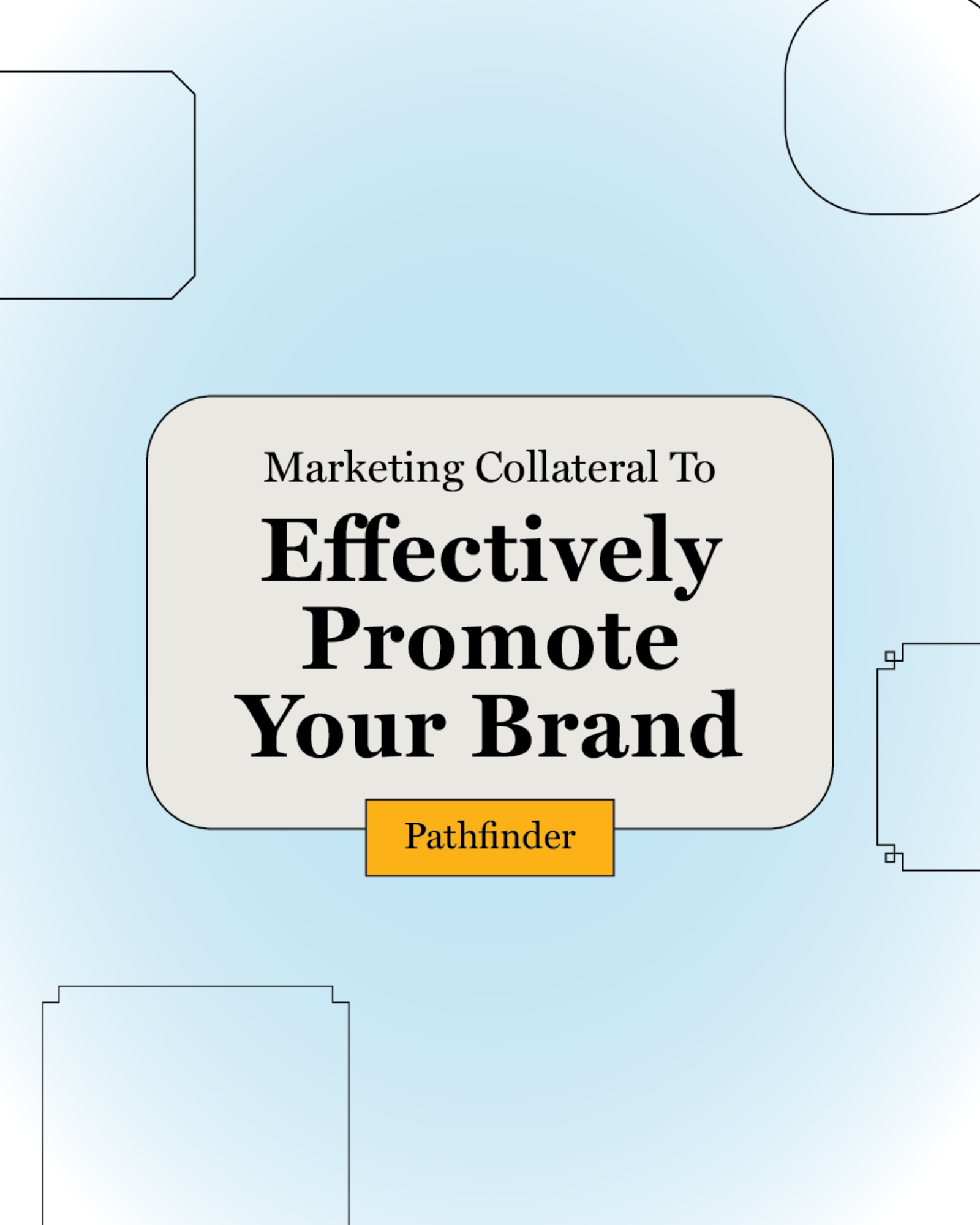Types of Marketing Collateral to Effectively Promote Your Brand
Marketing Collateral
It matters how you present and represent your brand, correct? Yes. And it’s also important to use different types of marketing collateral to promote your brand.
But, first…
What exactly is marketing collateral?
Marketers can use marketing collateral to build brand awareness, attract new leads, nurture existing leads, provide support for the sales team, increase customer loyalty, and win repeat customers.
Marketing collateral is any communication material or media you can use to promote your company’s product and services.
How?
Types of marketing collateral
- Blog Posts: Blog posts are among the most common collateral marketers create to attract more leads through Search Engine Optimization keywords. Blog posts are typically posted directly on your website but can be used as content pieces across all of your marketing platforms. It’s essential to create blog posts to help you alleviate your customers’ pain points and offer education that fills their knowledge gaps – keeping you the expert and their number one point of reference.
- Landing Pages: A landing page is a standalone web page created to convert traffic from advertising and marketing campaigns. Unlike other web pages with multiple links and different calls to action (CTAs), a landing page should have a single conversion goal—whether to make people download an ebook, sign up for your newsletter, buy a product, register for an event, or something else. Because they are specific and targeted, landing pages help marketers quickly convert their audience into leads and funnel them through your business.
- Branded Content: Branded content is created to build awareness about a brand by associating it with other content with aligned values. Examples branded e-books, apparel and products, podcasts, film projects, and more.
- Infographics: Infographics are a fun and visual marketing collateral you can create to engage your audience. Because of their graphic nature, infographics are handy for visualizing data, timelines, or breaking down complex subjects into a simpler and easier-to-understand format. Infographics are highly shareable, especially on platforms such as Pinterest and in email newsletters.
- Brochures: Unlike the other marketing collaterals we’ve mentioned already, brochures can appear both offline and online. Before the rise of the internet, companies primarily used brochures to promote their offerings to an audience through physical or in-person interactions. Although some companies still print physical brochures, many have chosen a digital format for their brochures. Making them cost effective and easily accessible to their audience. Whether printed or digital, brochures work because they’re visually appealing and versatile. For instance, a restaurant can create a single brochure that contains information about their menu, opening hours, and even coupons customers can cut and use. Or a marketing agency can use a brochure to showcase their services, share portfolio pieces, run ads for their clients, and provide educational content to the audience.
- Case Studies: Case studies are created to provide in-depth examinations into how customers use your products and services to solve their problems. Because they show other customers’ success with your product/services, they’re necessary marketing collateral in the sales process. Case Studies can live on a companies website (similar to a blog post), converted to video case study, or shared as an infographic. According to DemandGen’s 2021 Report, case studies are among the top content formats B2B buyers consider before making a purchase.
- eBooks & Downloadable Guides: eBooks and downloadable guides are created to educate an audience about a specific topic. eBooks also sometimes serve as an extension of your blog posts by allowing you to discuss specific topics at greater lengths.
- Podcasts: A podcast is an audio-focused marketing tool you can use to spread the word about your business. For example, Converge – a subsidiary of Pathfinder – recently started a podcast called Leadership LevelUp. The podcast is on niche and topic for Converge and helps open up the conversation about leadership development to a new audience. The Podcast is not used for direct selling but provides brand awareness and trust for Converge.
- Corporate Brochures & Magazines: Corporate brochures and magazines are publications companies use to showcase their products and services to customers. Although they might sometimes appear digitally, these brochures and magazines are usually printed. The brochures and magazines are expected to have an eye-catching design and contain content that educates and engages your audience. Most companies distribute this marketing collateral at in-person events or display counters at retail stores. Pathfinder recently released their first Marketing Booklet, coming soon to our local audience. The booklet is used to share our brand but also share about our clients, our community, and provide seasonally based topics of education for our audience.
- Product Catalogs: Product catalogs are marketing collateral that contains all the essential details about your products to help people make a purchase decision. These details include the product’s name, size, weight, price, pictures, available colors, description, reviews, and price, among other things. Contrary to what you might think, product catalogs work for various businesses, not just eCommerce businesses.
- Proposals & Presentations: Proposals & presentations are a type of marketing collateral used to provide an overview of a business or project plan to an audience or clients. For example, Pathfinder uses a fully developed and design proposal for all new clients and projects. The proposal includes more than just an itemized pricing sheet. We share our story, our brand, our purpose, our team, and how we can further help the client.
- Newsletters: Email marketing is one of the most cost-efficient ways to reach your customers today. Don’t take our word for it: Reports show that you get, on average, a $36 return for every $1 you spend on email marketing. One of the best ways to use email marketing is to run a newsletter. You can use your newsletter to keep in touch with your customers, promote your products, and nurture leads.
- Webinars: Webinars, or web seminars, are video-based online presentations hosted live using webinar software. These presentations could be training sessions, workshops, or classes that aim to pass information across in real-time to an audience. Due to the pandemic, more businesses are now using webinars than ever before. And they’re finding success with it as 76% of respondents on this ON24 survey mention that webinars helped them reach more leads.
- Testimonials: A testimonial is a statement from a customer or client endorsing your products and services based on their personal experience. Testimonials are vital because they serve as social proof and encourage others to buy from you. Therefore, your testimonial needs to be specific, personalized, and direct to get the most out of it.
- Email Signature: Although often overlooked, your email signature provides ample real estate for you to create marketing collateral. Instead of leaving your email signature area blank, include your name, position held, contact information, and company logo — all of which add to your company’s marketing whenever you send an email.
- Digital Report: If you run a company that collects a ton of data, you should create digital reports as a marketing collateral. These reports usually present an analysis and visualization of original data for the public. And because the reports are typically unique, it positions businesses who create them to receive a ton of backlinks. These digital reports can be internal based or niche/industry based.
What’s Next?
As you review the list above, don’t fret if you don’t already create these types of marketing materials. Instead, focus on creating the ones most relevant to your business! Marketing collateral is a powerful asset for your business – but only when used correctly. There is no need to stretch your time, resources, talent, and money to do it all. Plant yourself in the best possible position for your business.
Not sure where that is? Need help in creating and implementing marketing collateral for your business? Our team is here to help!










